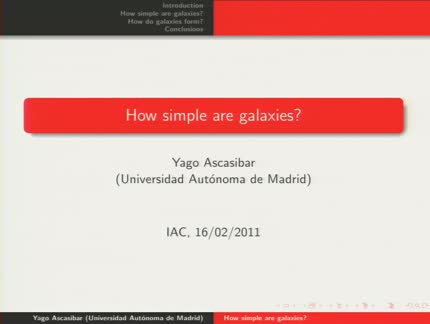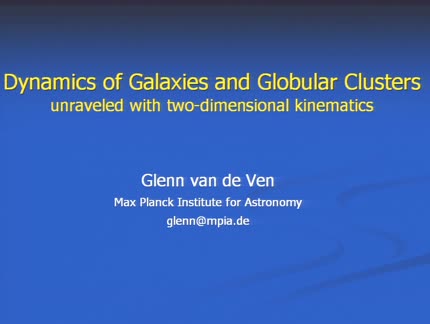Found 89 talks width keyword galaxy evolution

Abstract
The extragalactic background light (EBL) is of fundamental importance both for understanding the entire process of galaxy evolution and for gamma-ray astronomy, but the overall spectrum of the EBL between 0.1 and 1000 microns has never been determined directly from galaxy spectral energy distribution (SED) observations over a wide redshift range. Galaxy SED-type fractions from z=0.2-1 are estimated from a multi-wavelength sample from the AEGIS collaboration that allows a new determination of the evolving EBL. Then, the transparency of the Universe to very high energy (VHE) gamma-ray photons is derived. We find the maximum transparency of the Universe allowed by the standard framework. This result challenges current VHE observations of high redshift blazars. A solution to this problem is discussed utilizing VHE spectra of the highest redshift blazars assuming the existence of a plausible dark matter candidate known as axion-like particle.

Abstract
Spectroscopic analysis of stellar populations is widely used to understand the history of many systems including globular clusters, nuclear star clusters, dwarf galaxies through to giant galaxies over a wide range of redshifts. In this talk I first explore aspects of stellar population fitting, focussing on the effects of interacting binary stars on the yields and hence the spectra of early-type galaxies. The second part of the talk concentrates on what we know about supernovae type Ia and the importance of understanding their contributions to the chemical evolution of galaxies and stellar populations.

Abstract
Galaxies are arguably complex systems. However, they also display many scaling relations between their physical properties, hinting that it might be possible to summarize all this complexity within a few phenomenological parameters. In this talk, we will first address the question of how many parameters are indeed necessary in order to describe a galaxy, and then discuss some of them in detail, aiming towards a self-consistent, cartoon (yet remarkably accurate) picture of galaxy formation and evolution.
Abstract
Massive stars dominate the light output of entire galaxies, with luminosities in excess of 105 L⊙. This makes them powerful probes with which to study a range of astrophysical phenomena. In this talk I will review the recent results of our group, in which we have been able to shed new light on the recent star-forming history of our Galaxy, and the nature of supernova progenitors. I will also discuss our latest project, which is to use massive stars as tracers of extra-galactic star-forming histories out to distances of 10 Mpc and beyond.

Abstract
Early-type dwarfs (dEs) are by far the most abundant galaxy population in nearby clusters. Whether these objects are primordial, or recent end-products of the different physical mechanisms that can transform galaxies once they enter these high-density environments, is still a matter of debate. Here we present a novel approach to test the latter scenario by comparing the properties of the globular cluster systems of dEs and their potential progenitors with simple predictions from gravitational and hydrodynamical interactions. Current data in the literature do not favour violent mechanisms, but gentle processes with long timescales or that took place at the early stages of their formation.
Abstract
Massive (≥ 1011 M⊙) galaxies at high redshift (z ≥ 1.5) remain mysterious objects. Their extremely small sizes (effective radii of 1-2 kpc) make them as dense as modern globular clusters. It is thought that a highly dissipational merger is needed to create such compact type of galaxies. We will discuss this issue, along with state-of-the-art morphological and kinematic observations of these objects. In the present day Universe massive galaxies show large sizes, and harbor old and metal-rich stellar populations. In order to explore their development, we present near-IR IFU observations with SINFONI@VLT for ten massive galaxies at z=1.4 solely selected by their high stellar mass which allow us to retrieve velocity dispersions, kinematic maps and dynamical masses. We joined this with data and works coming from the GOODS NICMOS Survey, the largest sample of massive galaxies (80 objects) with high-resolution imaging at high redshift (1.7 < z < 3) acquired to date. As a result, we show how their morphology changes possibly through elusive minor merging.
Abstract
The distribution of matter in galaxies of different luminosities and Hubble types, as inferred from observations, plays an important role in cosmology, extragalactic astrophysics, astroparticle physics, as well as in a number of issues in high-energy astrophysics, galactic astronomy, star formation and evolution and general relativity. Not withstanding the general successes of the ΛCDM model in explaining the structure and evolution of the universe, there is a growing conviction that the structural properties of the dark and luminous components in galaxies hold important clues about the nature of dark matter and about the processes that are responsible for galaxy formation. This talk is part of an international initiative known as "Dark Matter Awareness Week".The overall purpose of this event is to increase the awareness of the phenomenology of the mass discrepancy phenomenon in galaxies amongst the many scientists currently working with a theoretical, observational, experimental and simulation approach on issues involving dark matter or its alternatives. The content of the talk will be at the level of a journal club talk with an important dose of review.

Abstract
Two-dimensional stellar kinematics obtained with the integral-field spectrograph SAURON allow the classification of early-type galaxies into 'slow' and 'fast' rotators, different from their morphological classification into ellipticals and lenticulars. Most fast rotators, including lenticular as well as many elliptical galaxies, are consistent with oblate axisymmetric disk-like systems. On the other hand, the slow-rotator ellipticals show clear deviations from axisymmetry, which can be modeled with our extension of Schwarzschild's orbit superposition method to triaxial geometry. Besides galaxies, I show that Schwarzschild's method can also be used to model in detail globular clusters such as ω Cen and M15. The recovered internal orbital structure of ω Cen reveals besides a signature of tidal interaction, also a central stellar disk, supporting its origin as the nucleus of a stripped dwarf galaxy. The formally best-fit Schwarzschild model for M15 includes an intermediate-mass black hole, but we cannot exclude a model in which dark remnants make up the dark mass in the collapsed core.

Abstract
CALIFA is the largest IFS survey ever performed up to date. Recently started, it will observe ~600 galaxies in the Local Universe with PPAK at the 3.5m of the Calar Alto Observatory, sampling most of the size of these galaxies and covering the optical wavelength range between 3700-7100 Å, using to spectroscopic setups. The main goal of this survey is to characterize the spatially resolved spectroscopic properties (both the stellar and ionized gas components) of all the population of galaxies at the current cosmological time, in order to understand in detail the how is the final product of the evolution of galaxies. To do so, the sample will cover all the possible galaxies within the color-magnitude diagram, down to MB ~ -18 mag, from big dry early-types to active fainter late-type galaxies. The main science drivers of the survey is to understand how galaxies evolve within the CM-diagram, understanding the details the process of star formation, metal enrichment, migrations and morphological evolution of galaxies.

Abstract
We present recent theoretical and empirical results concerning the accuracy of Cepheid distance estimates based on optical and near-infrared (NIR) Period-Luminosity (PL) relations. In particular, we plan to discuss the dependence of both slope and zero-point on the metal content using a large sample of extragalactic Cepheids. Moreover, we discuss pros and cons of optical and NIR reddening free Period-Wesenheit relations. We also mention the impact that GAIA will have on the precision of the Cepheid distance scale and the role that E-ELT will play in the identification of Cepheids beyond the Local Volume.<< First « Newer 1 | 2 | 3 | 4 | 5 | 6 | 7 | 8 | 9 Older » Last >>
Upcoming talks
- Classical Be stars - Constraining binary interaction physics in massive starsDr. Julia BodensteinerThursday April 25, 2024 - 10:30 GMT+1 (Aula)








